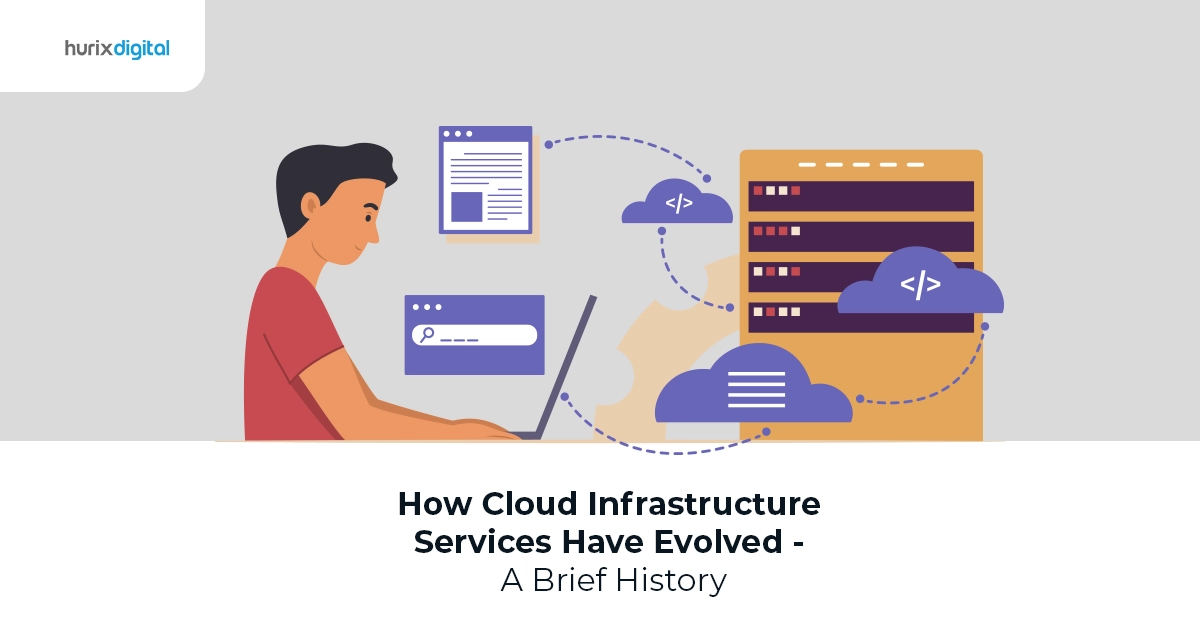
How Cloud Infrastructure Services Have Evolved – A Brief History
Summarize with:
Did you know that the market for cloud infrastructure services is expected to grow at a CAGR of 6.62% from 2024 to 2029, increasing from an estimated USD 77.5 billion in 2024 to USD 107.29 billion by 2029?
This growth is made possible by cloud infrastructure services’ ability to reduce the Time to Market (TTM). They will also be able to speed up the application development and running processes.
Thus, cloud infrastructure services offer lower costs, enhanced flexibility and scalability, and improved security. This also encourages several organizations to implement it to decrease their operational costs and better maintain their IT infrastructure.
Cloud infrastructure service is a very competitive market that is constantly advancing. In this article, we will discuss its growth and evolution over time.
Table of Contents:
What are Cloud Infrastructure Services?
Cloud infrastructure services are the hardware and software required to provide cloud computing. They include networking, storage, and virtualization resources like servers, network switches, storage clusters, and memory.
Also known as cloud application infrastructure services, these are used to create applications that users can access via the Internet, cloud, telecom services, and wide-area networks (WANs). They allow organizations to fulfill their data storage requirements and computing capabilities whenever they need them, removing the need to develop on-premise IT infrastructure and rent data center spaces.
Additionally, these services are available for public, private, and hybrid cloud systems. It can be taken on rent from cloud infrastructure providers. The key benefit of cloud infrastructure solutions that makes them attractive to businesses is that they give higher flexibility and scalability at a low cost of ownership.
Also Read: Free Up Your Cloud Budget: Uncovering Hidden Azure Cost Optimization Strategies
The Evolution of Cloud Infrastructure Services
Over the decades, the concept of cloud-based infrastructure has grown from being an innovative idea to one of the necessities and most demanded services in the present world.
Today, cloud computing infrastructure is one of those industries that is constantly growing, with cloud infrastructure companies developing new solutions to critical problems faced by organizations.
1. 1930 Early Computing by Alan Turing
The journey of cloud computing infrastructure began in the 1930s with Alan Turing’s work on early computing and his unprovable Entscheidungsproblem. This was basically the notion that a statement tends to be universally provable with enough computing power.
However, this led to the introduction of Turing’s complete mainframes like ENIAC. This involved huge, expensive, and shared machines that could carry out the computations mechanically through the manipulation of components like vacuum tubes and relays.
Multiple people and teams programmed and ran these mainframes. Additionally, time-sharing schedules were maintained to ensure that users had access to these setups when needed. The schedules enabled users to access the mainframes from any connected station or a tethered screen, which matches the basic premise of modern cloud infrastructure services.
2. Advanced Research Projects Agency Network (ARPANET), 1969
In 1969, a scientist named J.C.R. Licklider suggested an interconnected system of computers. This led to the development of ARPANET, which was the earliest version of the Internet.
The main purpose behind creating this system was to make information accessible for everyone and interconnect the world. This advancement allowed digital data to be shared between remote computers.
3. IBM’s Virtual Machine (VM) Operating System, 1972
This operating system resulted in the creation of a virtual computer that worked in the same way as a physical one. Additionally, other similar consumer-grade technologies started being developed. This also involved multiple hardware virtualization platforms that were parallel to Mac.
In fact, many Linux users use tools like Vagrant which have functionality similar to these earlier developments. Over the years, this advanced further and became virtual private networks used by businesses.
4. Modern Cloud Computing Infrastructure
In the 1990s, modern cloud computing infrastructure was developed, with Salesforce.com becoming the first cloud infrastructure company to offer software-as-a-service (SaaS) over the Internet. In 2004, technologies that can support huge amounts of data started being developed, including Google’s MapReduce paper.
A few years later, Hadoop was introduced. It could manage extremely large datasets on commodity hardware. By 2006, Amazon Web Services (AWS) and Elastic Compute Cloud (EC2) were created and released for public use. This made it possible for users to rent and use virtual machines as infrastructure for their data and applications. Google Docs was also released in the same year.
In 2007, companies like Google and IBM worked with multiple universities to create server farms with resources to research cloud-based projects. At the same time, companies like Netflix started introducing their streaming services.
By 2008, Apache Cassandra was launched. This advancement made it possible to distribute data across thousands of nodes. It also handled the read-and-write queries in a manner that was very similar to the current SQL. This capability of storing, distributing, transporting, collecting, and using huge volumes of data made cloud storage and management very appealing to all users.
By 2010, Google, Microsoft, Amazon, and OpenStack had introduced cloud divisions to make cloud services available to all users. From that point onwards, cloud infrastructure services have taken over the tech industry, making cloud migrations and transitions very common.
In fact, as more organizations started using cloud services, the idea of public, private, and hybrid clouds started developing. This was to help organizations improve the customization of their implementations while also encouraging them to integrate cloud services completely.
In 2011, Apple launched iCloud, allowing users to use cloud storage in their everyday lives. This mass acceptance led to an increasing number of SaaS releases. In 2018, this field was dominated by Google Compute Engine, Amazon EC2, IBM, Alibaba, and Microsoft Azure Virtual Machines.
Infrastructure as a service provides the fundamental resources for computation, storage, and networking to consumers over the Internet. Consumers can access these resources whenever they need them and on a pay-as-you-go basis.
Cloud infrastructure services also include platform as a service (PaaS). This refers to the cloud environment and tools provided for the development, deployment, and testing of applications. Some popular examples include Google App Engine, AWS Elastic Beanstalk, and Azure App Services.
5. Current Trends in Cloud Infrastructure Management
Since the COVID-19 pandemic, enterprises of all scales have started migrating their data and workloads to the cloud to ensure productivity and collaboration in a remote working environment. This led to an 18.4% increase in end-user spending on public cloud infrastructure.
By 2024, it is expected that 50% of new system deployments will be cloud-based, with generative AI playing a major role in this transition. Generative AI helps improve cloud data security by early detecting threats based on the datasets available. This will help set up proactive defense mechanisms and improve operational efficiency.
In addition to cloud computing in AI, businesses have started resorting to hybrid and multi-cloud solutions from different cloud infrastructure providers. These will help in effectively managing workloads while improving flexibility, reducing costs, and ensuring compliance with data sovereignty laws.
Edge Computing is also gaining popularity in cloud infrastructure management because it uses data generated locally to support real-time responsiveness. This helps monitor sensitive data and reduce the cost of data transmission to the cloud.
Also Read: The Ultimate Guide for Streamlined Cloud-Managed Services
Conclusion
Cloud infrastructure services have become important for every business organization because they help reduce costs, enhance operational efficiency, improve scalability and flexibility, and ensure business continuity. They also support a high level of automation and rapid infrastructure deployment.
By resorting to trustworthy Cloud Solutions by Hurix Digital, you will be able to have smarter and faster business with streamlined operations, seamless integration, assured scalability, and robust security. Contact Hurix Digital to learn more about how it can help you with cloud infrastructure management.
Summarize with:

Vice President and Strategic Business Unit Head – Cloud Services
A top technology management voice on LinkedIn with 20 Years of experience in Information Technology, Cloud Services, Digital Transformation, Application Modernization, Managed Services, IT Security Engineering and Operations Management. An avid technology Leader, Leadership Speaker, Author & Coach.
 A Space for Thoughtful
A Space for Thoughtful 



